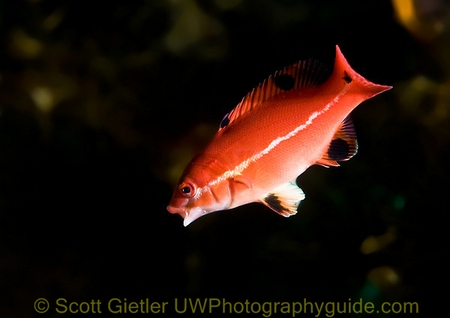Achieving Focus Quickly in Your Underwater Photography
Understanding how to focus faster
-
Your camera needs light to focus, more is better
-
Your camera needs contrast to focus (e.g. red against blue, contrasting light levels or color boundaries). The contrast needs to be in the area covered by the camera's active focus point.
-
A camera will usually focus faster with only one active focus point, e.g. - spot focus
-
A faster lens, which is a lens with a larger maximum aperture, will generally focusing faster than a slower lens. For example, the Canon S90 has a fast F2.0 lens.
-
Use Focus Check on the S90, S95, G11, and G12 cameras.
-
Wide-angle lenses generally focus much easier, especially fisheye lenses. You can read more about lens basics.

Juvenile Fish move fast and fish photography will really test your focusing capabilities. F7, 1/250th, ISO 200, 60mm lens + 1.4x teleconverter
What makes focusing more difficult?
-
Shooting at subjects far away
-
Low contrast subjects such as pelagic invertebrates
-
Low-light shooting (e.g. - at dusk)
-
Using a teleconverter or shooting supermacro photography
-
Longer lenses tend to hunt more and have more trouble achieving focus quickly. The longer the lens, the longer time it generally takes to focus.
-
Focusing is much more difficult on night dives.
-
Focusing is much more difficult in lower visibility water.

You don't want to miss out on moments like this because your camera won't fire. Navanax eating a Hermissenda nudibranch. F10, 1/200th, ISO 160, 60mm lens
Best tips for fast, quick focus in underwater photography
-
A strong focus light will help immensely with compact cameras and dSLR photographers shooting macro, especially with long lenses
-
If you don't have a focus light, use your dive light to illuminate the subject. Illuminate the subject with the edge of your dive light, achieve and lock focus, then move your light away to avoid getting a hot spot. Of course this will not be an issue if shooting at tiny apertures (F22) or very fast shutter speeds (F8, 1/200th).
-
Prefocus your camera and then switch to manual focus to eliminate focusing lag. However, you are then limited to one exact focus distance.
-
If your camera offers continuous focusing (C) - which is AI-Servo on Canon cameras, instead of single-servo (S), choose C. Your shutter will release as soon as your press the shutter, instead of waiting to achieve focus. Note - your camera may still hunt for focus, but when the subject is in focus, you will be able to take the shot. This has been the most helpful tool for achieving focus underwater with my Nikon D300.
-
Compact camera shooters can pre-focus by pressing the shutter half-way down, and then releasing the shutter at the right moment. This can take some practice though. Get used to composing the shot then locking the focus, exposure, etc. with a half-press. Once it's locked, the camera will take the shot almost instantly without much if any lag. Simply mashing the shutter on a point and shoot is a recipe for tons of terrible photos. If you simply can't get the camera to lock focus on the subject you're trying to capture, sometimes you can focus on something else that's the same distance, locking it in with a half-press, recomposing and then firing off the shot.
-
dSLR shooters can use focus lock, which locks the focus while the focus lock is pressed down. Many action photographers make heavy use of focus lock.
-
As mentioned above, wide-angle lenses generally focus more quickly. I rarely have trouble getting wide-angle shots in focus, and often combine continuous focus mode with a large number of focus points.
-
Using a larger depth of field, e.g. - a smaller aperture, will give you a little more wiggle room in case your focus isn't spot on, but this is usually more useful with wider photos. With macro shots at a long focal length, if the focus is off, a larger depth of field usually won't help.
Read our tutorial on Shooting Fast Action Underwater.

Clear subjects can be very difficult to focus on, a little luck always helps

This cormorant stopped for a split second. I was in continuous focus mode, with all 51 focus points turned on. F8, 1/25th, ISO 250, Tokina 10-17mm fisheye lens
Thanks to Dana, Todd, Kalani, Bonnie for their input to this article.
Further Reading

RECOMMENDED ARTICLES
SUPPORT THE UNDERWATER PHOTOGRAPHY GUIDE:
The Best Service & Prices on u/w Photo Gear
 Visit Bluewater Photo & Video for all your underwater photography and video gear. Click, or call the team at (310) 633-5052 for expert advice!
Visit Bluewater Photo & Video for all your underwater photography and video gear. Click, or call the team at (310) 633-5052 for expert advice!
The Best Pricing, Service & Expert Advice to Book your Dive Trips
 Bluewater Travel is your full-service scuba travel agency. Let our expert advisers plan and book your next dive vacation. Run by divers, for divers.
Bluewater Travel is your full-service scuba travel agency. Let our expert advisers plan and book your next dive vacation. Run by divers, for divers.































